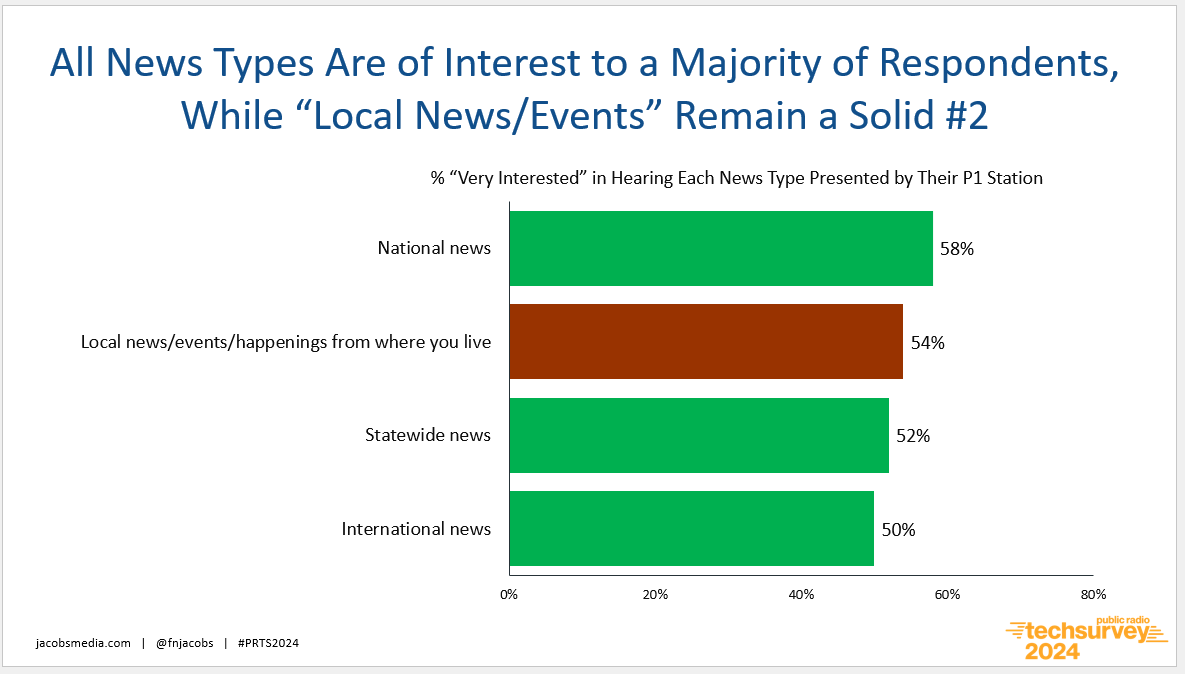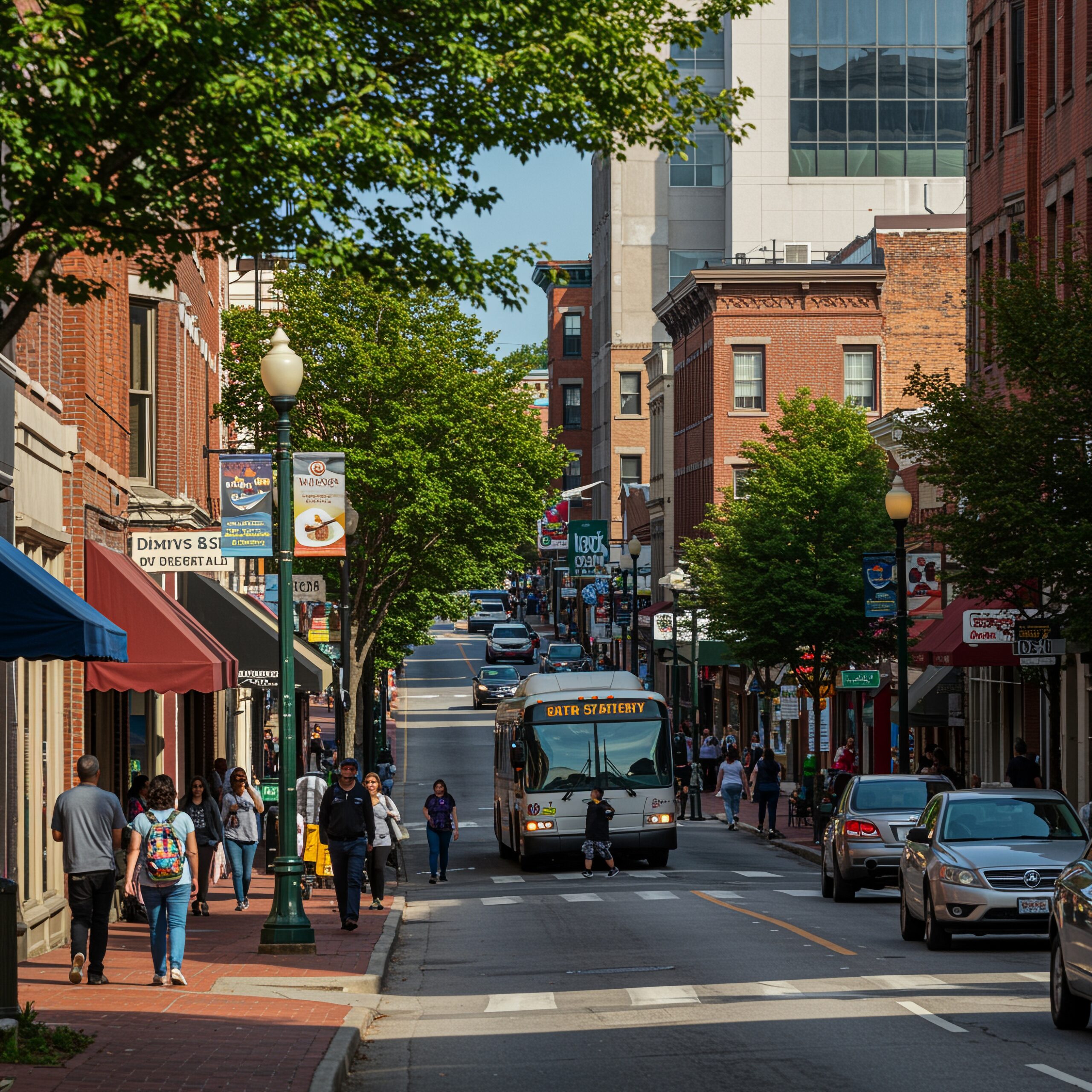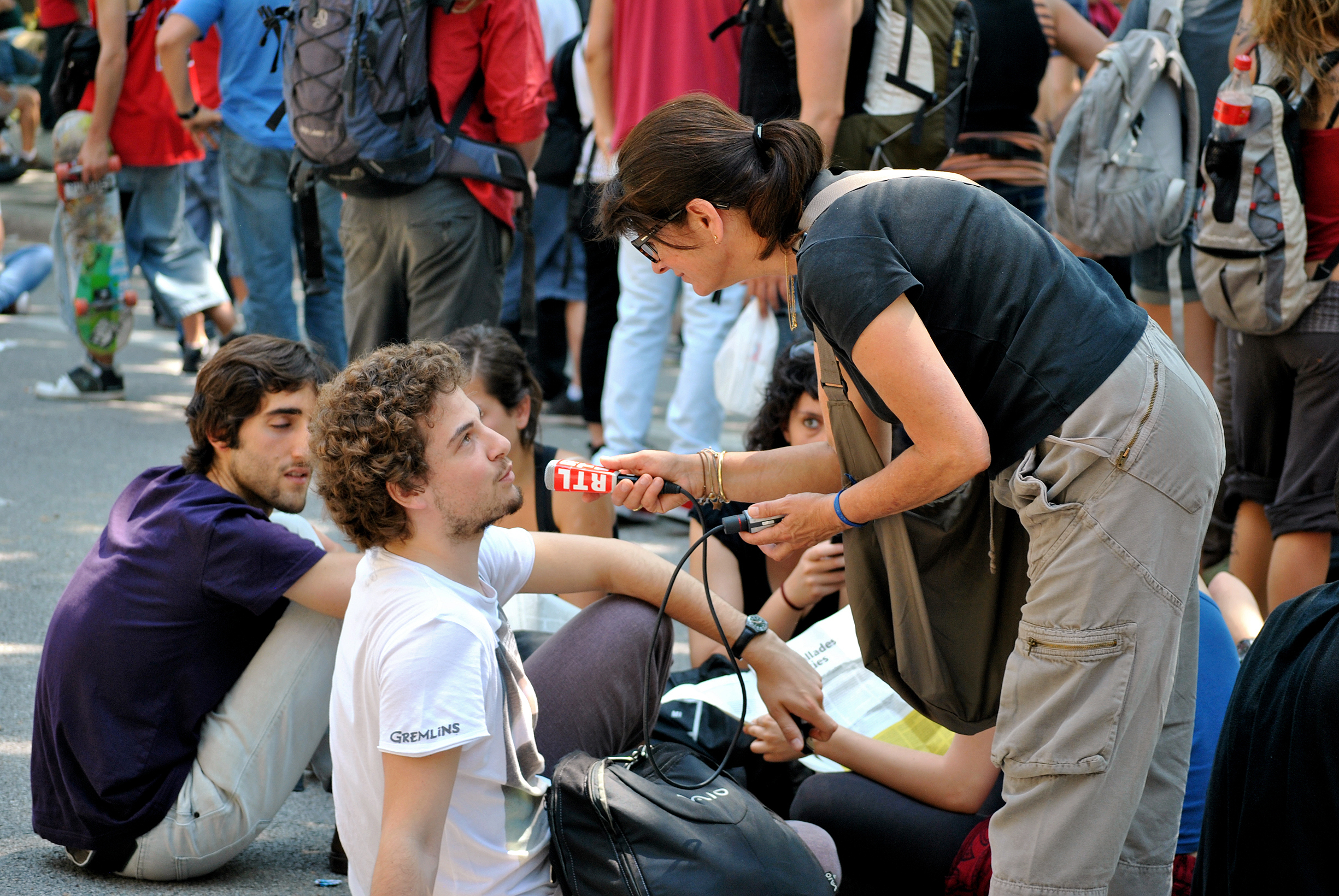
Is there something afoot about the rising importance of LOCAL news?
Maybe it’s not quite tsunami-force just yet and perhaps it’s an exaggeration to say it’s taken Americans by storm, but there is something going on when it comes to interest in the news from one’s city, town, or community.
It’s one of those phenomena I believe is occurring because I see those undeniable signs, coming not from just one research study, but showing up again and again when we solicit audience feedback on behalf of news-oriented stations both qualitatively and quantitatively. As many of you know, Jacobs Media has conducted 16 annual versions of our Techsurveys among public radio listeners in the U.S. And the signs are undeniable.
A look back at the news cycle in America is telling, particularly how it appears to have impacted not just public radio’s news and talk stations, but also their outlets that play music. The famous “Trump Bump” that propelled the ratings during that groundbreaking and shocking first term was followed by the swift impact of a pandemic that rocked the entire world.
But as our studies have clearly shown, while COVID was most certainly a global game-changer, its true and latest impact have been felt locally. The more citizens become resigned to world and national affairs being set in stone, the more they turn to the local environs to attempt change.
 The pandemic refocused many of us on what was going on in our immediate vicinity: which stores had toilet paper and hand sanitizer in stock, which area restaurants were still serving, and of course, where were social distancing and mask wearing required behavior. We learned that while our Senators or Congressmen might be a bit removed, the local superintendent of schools was, in fact, an important player in our townships and municipalities.
The pandemic refocused many of us on what was going on in our immediate vicinity: which stores had toilet paper and hand sanitizer in stock, which area restaurants were still serving, and of course, where were social distancing and mask wearing required behavior. We learned that while our Senators or Congressmen might be a bit removed, the local superintendent of schools was, in fact, an important player in our townships and municipalities.
Since the scourge of COVID, we have watched listeners robustly embrace the importance of news from local cities and communities. At first, we might have written off these gains as statistical “wobbles.” But over time, the trend has become clear.
And we’ve watched local coverage by news organizations become an important factor in their rankings in PRTS 2024. But don’t take my word for it—take a look at how more than 22,000 core public radio listeners responded in last year’s Public Radio Techsurvey. When we asked them to rate the news coverage that most drove their interest, national news took top honors, but local news was an impressive #2:

But here’s where the story gets even more interesting. When we break it down generationally, we see interest in local news shoot to the top of this chart among both Millennials and Generation X—age groups most public radio stations covet, but often find elusive. And if even the best stations are to weather the current storm they find themselves in, younger demographics—particularly Xers—may be the secret to sustainability.

How much of this rekindled interest in local is “real” versus to what degree is it being driven by perception? That is, does the very use of the word “local” drive more credibility?
A recent opinion piece by The Seattle Times’ Brier Dudley indicates that image plays a role. He quotes a recent study conducted by the American Journal of Political Science, titled “Can Americans’ trust in local news be trusted?” If you’re in the radio news business, it’s worthy of your time and attention.
Among the insights about the ascendant rise of local news is this one: People use “a news outlet’s local orientation as a shortcut to assess its credibility.”
 As Dudley concludes, “If a news source appears local, people are inclined to trust it.” (Italics are mine.) That’s an important finding for any local news medium to get its head around.
As Dudley concludes, “If a news source appears local, people are inclined to trust it.” (Italics are mine.) That’s an important finding for any local news medium to get its head around.
And thinking about it from a public radio standpoint, I’m hard-pressed to think of any news/talk stations I’m familiar with that would take top honors in “the best local news coverage of the city or town where I live” perceptual contest.
The lift is a heavy one, especially for most public radio stations. On the local beats, it requires regular news coverage with high quality and standards. It also requires smart, consistent messaging, a radio skill where most non-commercial stations—by definition—usually come up short. And given the plethora of news outlets and the scarcity of marketing resources, public stations have to be more intentional about staking out the hometown turf and making it a goal to win the reputation for delivering it.
As anathematic as this may sound, the “local” franchise just might make up the foundation of a new road map for public radio, especially given how so much of everyone’s research has pointed to the hometown opportunity in recent years. But there are barriers, mainly local TV news and social media.
In the case of the former, most commercial television stations are facing the same pressures as their linear counterparts on the AM and FM bands. But thanks to the development of their personalities and a dogged emphasis on local and neighborhood news—including crime—many TV stations have a distinct advantage, especially up against public radio’s news/talk stations where the bulk of programming content remains network based. At least, for the moment.
Social media is the other speed bump in the pursuit of younger consumers attempting to discover “what’s goin’ on?” Whether public radio managers like it or not, social is often the starting point for seeking out news and information of all varieties.
 Given that most public radio stations aren’t exactly leading the league in social media content creation, there’s a notable gap here. In fact, most aren’t even prioritizing social as a place where their journalists need to be present.
Given that most public radio stations aren’t exactly leading the league in social media content creation, there’s a notable gap here. In fact, most aren’t even prioritizing social as a place where their journalists need to be present.
The local piece is similarly an opportunity, but how do public radio’s news/talk stations get there from here, especially when most are overloaded with nationally syndicated programming?
Our research dictates we look at this period as an important moment in public radio’s timetable. We know this from a fundraising standpoint, especially as public radio organizations find themselves embattled by the current administration’s penchant for ending government financing. Those efforts are already producing notable increases during pledge drives, as many core listeners feel emboldened to support these stations with personal contributions.
But also from a content origination perspective, many public radio’s news/talk stations are making difficult analyses of their programming mix, assessing long-in-the-tooth network programs versus the time and costs involved in producing viable local replacements.
For many, it starts…and ends…with the local newsroom. Many public stations, even in medium and smaller markets, have more reporters than the commercial stations in town. Boots (sandals, and Crocs) on the ground is an advantage, of course, but only if they’re deployed with an eye toward strategy. Too often, what are supposed to be local news breaks during NPR shows such as Morning Edition and All Things Considered contain national and international stories as so-called local hosts during these shows are repetitively reading national and even international stories, even though they already receive more than enough coverage throughout the broadcast day. This deprives listeners of local news coverage while adding to the perception the same stories receive coverage multiple times across most days.
commercial stations in town. Boots (sandals, and Crocs) on the ground is an advantage, of course, but only if they’re deployed with an eye toward strategy. Too often, what are supposed to be local news breaks during NPR shows such as Morning Edition and All Things Considered contain national and international stories as so-called local hosts during these shows are repetitively reading national and even international stories, even though they already receive more than enough coverage throughout the broadcast day. This deprives listeners of local news coverage while adding to the perception the same stories receive coverage multiple times across most days.
At root, too many public radio stations train reporters responsible for the locally originated segments in network shows as “babysitters,” more focused on paying attention to the clock than they are to being accountable for their content when it’s time to open their mics.
Looking at these news departments in aggregate, what is the best way to teach veteran journalists how to best embrace the local opportunity?
Send ’em back to school…literally.
 A new story from Nieman Lab—“How student journalists are making national news local”—goes right to the heart of both the challenge and the opportunity in markets as diverse as Arkansas and Ithaca, New York.
A new story from Nieman Lab—“How student journalists are making national news local”—goes right to the heart of both the challenge and the opportunity in markets as diverse as Arkansas and Ithaca, New York.
As the article points out, the emphasis boils down to the essence of what drives all media content:
“Knowing your audience.”
Even though the national news beat may be making all the headlines at present, “localization has become a bigger newsroom priority this semester, following internal conversations about how national stories should be approached and made relevant to the university audience.”
Thus, journalists ask themselves whether the national headlines of today have relevance to their campus. A Trump address to Congress last March was covered by a local reporter who connected with campus groups before the speech to set up interviews following the president’s remarks.
The Nieman story notes that part of the prep that went into providing a local perspective to this news event was providing both a Democratic and Republican perspective, something public radio might also consider.
In this way, the students asking themselves whether there’s a local application to national stories has created its own litmus test to whether it will make the cut.
The story goes on to list a number of ways these students are creatively presenting national stories through the local lens.
As public radio stations search for ways to direct their newsrooms in the best direction in which to steer their coverage, the local piece isn’t just strategically sound—chances are, it truly reflects the desires of large swatches of the general audience and station donors.
desires of large swatches of the general audience and station donors.
For that next fundraiser, making it clear how donations will be earmarked to represent the station’s local reporting efforts, including the hiring of a local reporter(s), is also additive to the narrative.
Of course, it’s essential not just to use the local news filtering process but also to train local journalists on the importance of producing these stories for multiple formats. This includes social, video, visual resources (photos, maps), podcasts, and other places where repurposed content can find an appreciative audience.
For public radio, in particular, rethinking its POV may be an essential element in its ability to not only survive but to thrive.
The potential is there. The late Roone Arledge, famed sports and broadcast executive who knew something about the public taste, once made this conclusion:
“People essentially like local news better than network news.”
Amen.
- Is It Time For Radio to WAKE UP?! - June 1, 2025
- For Radio, The Perils Of Rebranding - May 30, 2025
- There’s No Failure In Radio - May 29, 2025




Great perspective, as usual. I would just like to add that being local does not mean that the entirety of the broadcast schedule need to be locally generated. Localness isn’t just about what you put on the airwaves. Its how you show up, how visible you are and how engaged and connected your station is to the communities you serve. Service isn’t just broadcasting. Hosts can’t just show up, do their shifts and leave. And by the way, reporters reading AP copy is NOT HOSTING! That’s just filling in local holes in national programming. In today’s media world, trust is carried as much by our personalities as our brands. So instead of making more radio shows or audio pieces that ONLY are intended for broadcast, lets think about how we connect with our communities through that storytelling and reporting. The 3-minute story should be the beginning of the conversation among the community, but too many stations treat it as the end game. Once the audio piece is done and aired and posted, the station is on to the next story. Connection is the name of the game today.
Fred, could the Local interest shown by Millennials and GenXers in your survey be propelled by trust? The social news cycle trends national and becomes overwhelming and partisan depending on which platform you’re reading or watching.
When my local station reports on a City Council transportation initiative, it may not be the most compelling content, but it’s unique and creates a break from the trending noise. More importantly, I feel like the newsroom isn’t reporting on “what’s trending,” but what I need to know about my community. There’s some trust in there.
Ron, i think that’s right. And that checks out with the study from the American Journawl of Political Science as reported by The Seattle Times. Covering local stories is a buiidiing block in earning audience trust.
I was part of a news department in the 80-90’s in a small market on a talk station that evolved from a full service station. In PM drive we stopped down once an hour for a locally produced newscast with stories only from the neighboring state, 20 miles away (lots of commuting between the two). The practice started decades prior to my arrival. First consultant I worked with said “why segregate? Just read the most relevant stories from both states in the same (already scheduled) local newscast”. Duh! Yes. Years later the same theory combined “local” news and national stories into a couple minute newscast for fm music stations. Again…duh. My theory is it’s not “local for the sake of local” that wins, it’s relevance. May seem simple, but the people carrying the burning torches crying LOCAL seem to often miss the point. In my case scrolling through “X” yesterday the two stories that I actually clicked on to read were the stabbing at the track meet at a Texas HS and the torching of the PA. Governors mansion. Neither of which did I see or hear about elsewhere (at least in front of my eyeballs or in my ear). I live in neither state. Neither are local to me…was there anything as meaningful “locally to me” in the last 48 hours? Not that I can “remember”….
Fred (it’s always fun for me to connect with another Fred), we agree that the biggest stories of the day are what’s important. My point with public radio is that so much of the programs content comes from elsewhere that when it’s finally time for a break from the local market, it’s important not to repeat the same big stories we just heard (or will hear soon), and instead, tell the listener what’s happening here in Syracuse, Seattle, or Sagninaw. Thanks for your comment.